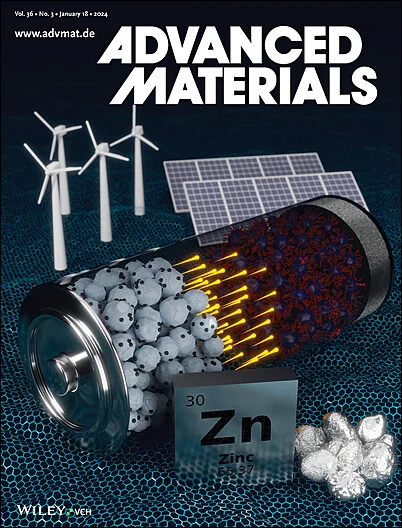Amidation-Retarded Synthesis of Perovskite Quantum Dots with Low Defect Density and Enhanced Carrier Transport for Efficient Light Emitting Diodes and Solar Cells.
IF 26.8
1区 材料科学
Q1 CHEMISTRY, MULTIDISCIPLINARY
引用次数: 0
Abstract
Perovskite quantum dots (PQDs) are promising for both solar cells (SCs) and light emitting diodes (LEDs) for their excellent optoelectronic characteristics and solution-processable fabrication. One of the general limitations for these two kinds of devices is that high defect density and poor charge transport, resulting from the unavoidable amidation-induced PbX2 precipitation at high reaction temperature. In this work, an amidation-retarded synthesis strategy is proposed to prevent the PbX2 precipitation and subsequent defect formation. Covalent metal halides are introduced to interrupt amidation by reacting with deprotonated oleic acid/protonated oleylamine. Then, free acids/amines are released to coordinate with PbX2 and form regular lead-halide octahedra during nucleation-growth process. The synthesized CsPbI3 PQDs exhibit lower defect density (5.1 × 1017 cm-3), higher PLQY (92%) and better charge output capacity (≈8 times improvement). As a result, the LEDs and SCs achieve a maximum external quantum efficiency of 28.71% and power conversion efficiency of 16.20%, respectively, representing the state-of-the-art performance. Furthermore, the universality of such strategy has been demonstrated in red/green/blue LEDs, and could be expected in other optoelectronic devices.用于高效发光二极管和太阳能电池的低缺陷密度钙钛矿量子点的缓溶合成和增强载流子输运。
钙钛矿量子点(PQDs)以其优异的光电特性和溶液可加工的制造工艺,在太阳能电池(SCs)和发光二极管(led)中都有应用前景。这两种器件的一个普遍限制是缺陷密度高,电荷输运差,这是由于在高反应温度下不可避免的偕酰胺诱导PbX2析出造成的。在这项工作中,提出了一种缓化合成策略来防止PbX2的沉淀和随后的缺陷形成。引入共价金属卤化物,通过与去质子化油酸/质子化油胺反应来中断酰胺化。然后,在成核生长过程中,释放游离酸/胺与PbX2配合形成规则的卤化铅八面体。合成的CsPbI3 pqd具有较低的缺陷密度(5.1 × 1017 cm-3),较高的PLQY(92%)和较好的电荷输出容量(≈8倍)。因此,led和sc的最大外量子效率分别为28.71%和16.20%,代表了最先进的性能。此外,这种策略的通用性已经在红/绿/蓝led中得到了证明,并且有望在其他光电器件中得到应用。
本文章由计算机程序翻译,如有差异,请以英文原文为准。
求助全文
约1分钟内获得全文
求助全文
来源期刊

Advanced Materials
工程技术-材料科学:综合
CiteScore
43.00
自引率
4.10%
发文量
2182
审稿时长
2 months
期刊介绍:
Advanced Materials, one of the world's most prestigious journals and the foundation of the Advanced portfolio, is the home of choice for best-in-class materials science for more than 30 years. Following this fast-growing and interdisciplinary field, we are considering and publishing the most important discoveries on any and all materials from materials scientists, chemists, physicists, engineers as well as health and life scientists and bringing you the latest results and trends in modern materials-related research every week.
 求助内容:
求助内容: 应助结果提醒方式:
应助结果提醒方式:


